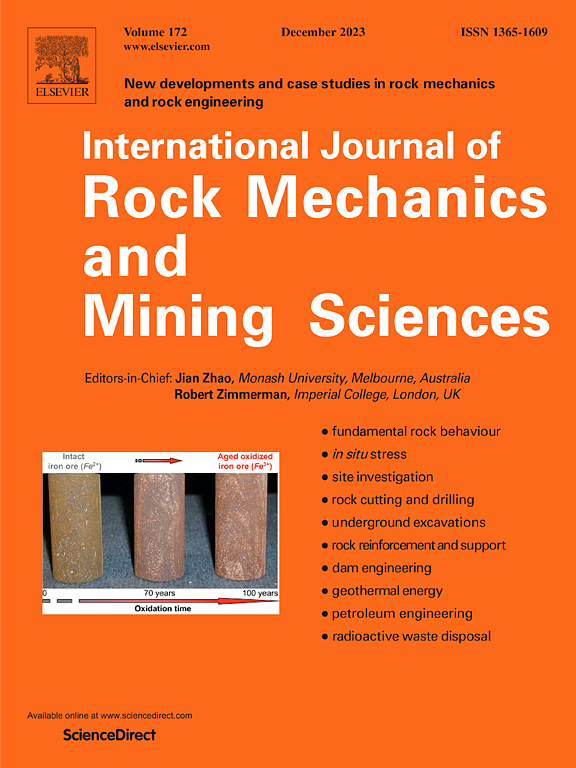Failure and post-failure kinematic disaster processes of columnar rock masses based on 3D discontinuous deformation analysis
IF 7
1区 工程技术
Q1 ENGINEERING, GEOLOGICAL
International Journal of Rock Mechanics and Mining Sciences
Pub Date : 2025-02-01
DOI:10.1016/j.ijrmms.2024.106003
引用次数: 0
Abstract
Columnar dangerous rock masses are considered important hazardous rock formations because of their ubiquity, abrupt failure, and high collapse frequency. The kinematic processes following their failure directly trigger geological disasters. This study investigates the failure and post-failure kinematic disaster processes of columnar rock masses using three-dimensional discontinuous deformation analysis (3D DDA). A comprehensive experimental system was established, and three sets of columnar laboratory models were employed to validate the 3D DDA simulations. Focusing on the Wangxia columnar rock mass, the failure and movement modes of single and multiple blocks were analyzed, considering the cutting of the structural planes within the rock column. Results demonstrated the high accuracy of 3D DDA in analyzing the kinematic disaster processes associated with the failure of columnar rock masses. With increasing number of cutting-surface combinations, the failure and movement modes of the blocks diversified and the durations of their oblique projectile motions after each collision with the slope decreased. Kinetic energy transfer between colliding blocks altered their initial trajectories and increased their movement durations compared with the observations for the single block. As the overall failure length of the columnar rock mass increased, the failure and movement modes of the blocks as well as the associated energy conversions changed, providing insights into the ensuing disaster mechanisms. Further, this study evaluated the impact of rock mass failure on highway traffic and predicted the disaster scope, providing a theoretical foundation for the development of disaster prevention strategies.
基于三维非连续变形分析的柱状岩体破坏及破坏后的运动灾害过程
柱状危险岩体因其普遍存在、破坏突然、崩塌频率高而被认为是重要的危险岩层。断裂后的运动过程直接引发地质灾害。采用三维非连续变形分析(3D DDA)对柱状岩体的破坏和破坏后的运动学灾害过程进行了研究。建立了完善的实验系统,采用三套柱状实验室模型对三维DDA仿真进行了验证。以王夏柱状岩体为研究对象,在考虑柱内结构面切割的情况下,分析了单块体和多块体的破坏和移动模式。结果表明,三维DDA在分析与柱状岩体破坏相关的运动灾害过程中具有较高的精度。随着切割面组合次数的增加,块体的破坏和运动方式多样化,每次与坡面碰撞后的斜射运动持续时间缩短。与单个块的观测结果相比,碰撞块之间的动能传递改变了它们的初始轨迹,增加了它们的运动持续时间。随着柱状岩体整体破坏长度的增加,块体的破坏和移动模式以及相关的能量转换发生了变化,这为后续的灾害机制提供了线索。进一步评价了岩体破坏对公路交通的影响,预测了灾害范围,为制定灾害防治策略提供了理论依据。
本文章由计算机程序翻译,如有差异,请以英文原文为准。
求助全文
约1分钟内获得全文
求助全文
来源期刊
CiteScore
14.00
自引率
5.60%
发文量
196
审稿时长
18 weeks
期刊介绍:
The International Journal of Rock Mechanics and Mining Sciences focuses on original research, new developments, site measurements, and case studies within the fields of rock mechanics and rock engineering. Serving as an international platform, it showcases high-quality papers addressing rock mechanics and the application of its principles and techniques in mining and civil engineering projects situated on or within rock masses. These projects encompass a wide range, including slopes, open-pit mines, quarries, shafts, tunnels, caverns, underground mines, metro systems, dams, hydro-electric stations, geothermal energy, petroleum engineering, and radioactive waste disposal. The journal welcomes submissions on various topics, with particular interest in theoretical advancements, analytical and numerical methods, rock testing, site investigation, and case studies.

 求助内容:
求助内容: 应助结果提醒方式:
应助结果提醒方式:


